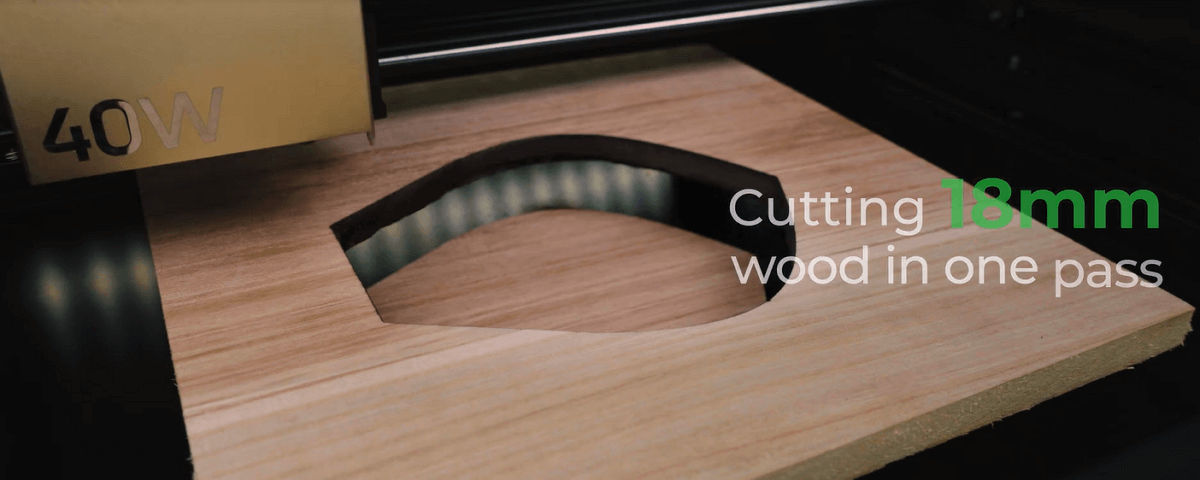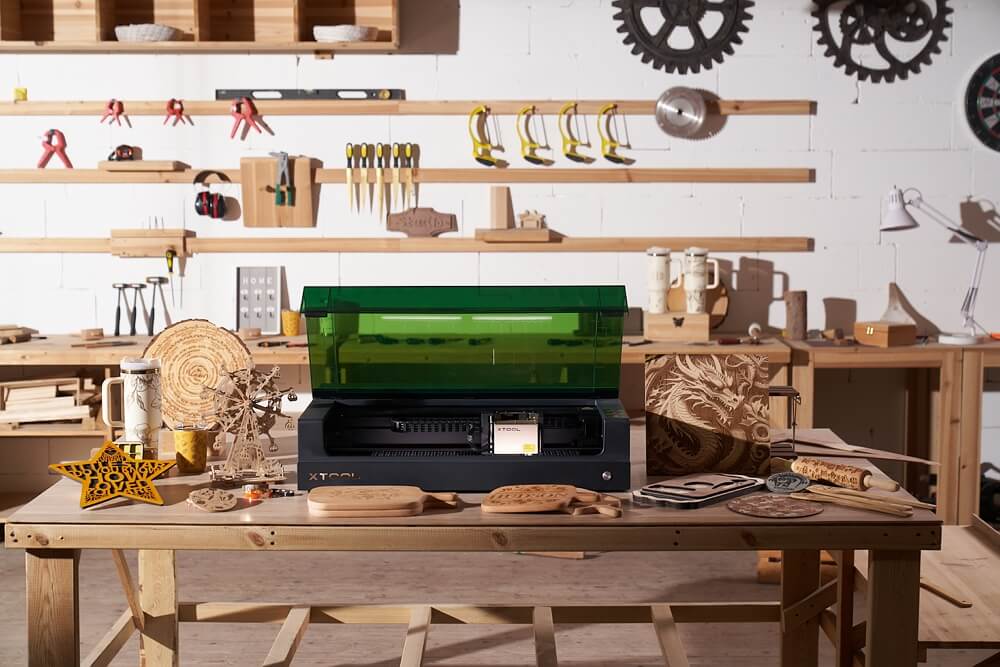Fiber Laser vs. CO2 Laser vs. Diode Laser: What's the Difference?
Laser engravers and cutters are commonly available nowadays. Many people use them to create all kinds of crafts to make homes sweeter, use them as gifts for friends and family, or sell them to have an extra income.

Among all laser machines, fiber laser engravers, CO2 laser engravers and diode laser engravers are three types of laser engravers used by most people. But if you get confused about the differences between them, and which laser is perfect for your laser engraving and cutting projects or business, you are not alone.
All these types of laser engravers have distinct characteristics, pros, and cons, and they are used for different purposes.
In This Article
- What Is a Diode Laser Engraver?
- What Is a CO2 Laser Engraver?
- What is a Fiber Laser Engraver?
- Diode vs CO2 vs Fiber Laser Engraver: Which Laser to Choose?
- Best Diode Laser Engraver and Cutter
- Best CO2 Laser Engraver and Cutter
- Best Fiber Laser Engraver and Cutter
- Conclusion
What Is a Diode Laser Engraver?
Diode laser engravers are a type of solid-state lasers. A diode is a semiconductor that is made by combining p-type and n-type material. One side of the diode is p-type, and the other side is n-type.
The p-type and n-type materials are joined together, and the junction is called a p-n junction. Laser beams are emitted from this junction.
After applying the potential difference at the ends of the diode, electrons from the n-type travel towards the p-type, and the holes in the p-type travel towards the n-type, which works similar to LEDs, but the output is very intense and coherent, consisting of a single frequency. Multiple laser diodes are used for high intensity, which is commonly called a diode bank.

The beams coming from the diodes are deflected using mirrors and passed through a converging lens. They converge the laser beams into a very fine spot which produces intense heat. The material at which the laser beams fall vaporizes quickly.

What Is a CO2 Laser Engraver?
Named after the gas used inside the discharge tube, CO2 laser engravers were the earliest gas lasers that were invented in 1964. They have now become one of the most common types of laser engravers on the market and are widely used by small businesses.
In a CO2 laser engraver, a discharge tube is filled with numerous gasses (also known as gas-filled tube), but CO2 is in the highest proportion, which is why the laser is called the CO2 laser. The other gasses inside the discharge tube are hydrogen, helium, oxygen, nitrogen, and xenon.

There are two electrodes at the ends of the discharge tube. When a high voltage is applied to the electrodes, the nitrogen molecules are excited. In the excited state, the molecules are in a metastable vibrational state. These molecules excite the CO2 molecules present in the discharge tube. When the excited CO2 molecules come in contact with the helium molecules, intense energy is released in the form of light or photons. These photons are the laser beams that are used to cut and engrave materials.
The light or laser beams that come out of the tube are pretty powerful. They instantly increase the temperature of the object that comes in contact and vaporize the material in no time.
What is a Fiber Laser Engraver?

Fiber laser engravers are also a type of solid-state laser. They get energy from diode lasers or other types of lasers, then the energy is activated and amplified by an optical fiber doped with rare-earth elements.

The amplified laser beams are highly power. The final laser coming out from the converging lens is capable of cutting metals.
Diode vs CO2 vs Fiber Laser Engraver: Which Laser to Choose?
1. Materials the Lasers Can Cut and Engrave
The decision to select a type of laser first depends on the materials you want to engrave and cut. First of all, if a laser can cut certain materials, it can also engrave them. But if a laser can engrave certain materials, it is not necessary it can cut them. For cutting, high power is needed compared to engraving.
a. Materials Compatible with Dioder Laser Engravers
If you want a laser machine for crafting or starting a small business, a diode laser is a suitable option as it can cut and engrave a wide range of materials we commonly use. Diode laser machines can easily cut wood, plywood, acrylic(opaque), cardboard, paper, and leather. These are the common materials that almost all laser diode machines can cut according to their power.
The materials that can be engraved by a diode laser engraver are wood, plywood, acrylic, paper, leather, metals, glass, ceramics, and a few more materials.
| Engraving | Cutting |
|---|---|
| Wood | Wood |
| Plywood | Plywood |
| MDF | MDF |
| Leather | Felt |
| Paper | Leather |
| Some opaque acrylic | Paper |
| Dark glass | Some dark acrylic |
| Stone/Ceramic/Jade/Marble/Shale/Cement/Brick | |
| Plated metal/Coated metal | |
| Fabric |
b. Materials Compatible with CO2 Laser Engravers
CO2 laser machines are better than diode laser machines in terms of cutting materials. They can cut and engrave a broader range of materials. And due to its 10,640nm wavelength being absorbed the majority of non-metals, CO2 laser engravers can work on almost all non-metals.
A CO2 laser can cut wood, plywood, MDF, acrylic (all colors), foam, paper, cardboard, leather, plastics, fabric, and rubber. The materials that a CO2 laser can engrave are acrylic (all colors), wood, plywood, MDF, leather, plastic, glass, fabric, rubber, brick, ceramics, bone, and coated metals.
| Engraving | Cutting |
|---|---|
| Acrylic (all colors)/Plastic | Acrylic (all colors)/Plastic |
| Wood/Plywood | Wood/Plywood |
| MDF | MDF |
| Leather | Fabric |
| Paper | Leather |
| Glass | Paper |
| Rubber | Foam |
| Stone/Ceramic/Jade/Marble/Shale/Cement/Brick | Rubber |
| Plated metal/Coated metal | |
| Fabric |
c. Fiber Laser Engravers
Fiber laser machines can cut and engrave most metals and some non-metals. It cuts and marks metals that other laser machines cannot do. They can engrave and cut aluminum, brass, copper, ceramics, tungsten, chrome, painted metal, fiberglass, carbon fiber, nickel, silver, gold, stainless steel, plastics, etc.
2. Laser Power
Beginners need to understand a few things while considering the power of a laser machine. There are three types of power ratings mentioned for laser machines. The three types are laser optical/output power, laser electric power, and machine power.
Machine power refers to the input power of the machines. It does not represent the power of a laser. The second one is the laser electric power, which is the input electrical energy taken by the laser module. The power is related to the laser module, but it does not represent the ability of the laser to engrave and cut an object. However, it can be used to understand the electricity consumption of the laser module.
The most important power is the laser optical/output power. It is the power that shows the ability to cut and engrave materials. The laser coming out of the module has optical power, and buyers need to see this power to understand what a laser machine can do.
The machine power rating is always the highest, and then comes the laser electrical power, and finally the laser optical power. For instance, a diode laser machine has an optical power of 10W, electric power of 40W, and machine power of 60W. Beginners get confused between laser electrical power and optical power. Some companies also scam people by telling them the electrical power instead of optical power. Thus, you always need to see the optical power of the machine for comparison.
a. Optical Power of Diode Laser Engravers
Diode lasers have the lowest optical power compared to other types of laser engravers. They are typically 5-40W. However, they can cut and engrave all materials we have discussed. Even this low power is suitable for small businesses. If the power is low, then there will be more passes required to cut or engrave the materials.
xTool has introduced the world's most powerful diode laser module with 40W optical power. The module is very powerful, which can cut up to 18mm wood in one pass. It does the job quickly and with high precision. It increases the efficiency of a diode laser engraver.

b. Optical Power of CO2 Laser Engravers
CO2 laser engravers are more powerful than diode lasers. They can cut more objects as the laser beams provide more heat energy. The optical power of CO2 lasers ranges from 40W to 300W, making the machine are excellent for cutting and engraving more materials.
c. Optical Power of Fiber Laser Engravers
Most fiber laser engravers available on the market are industry-grade, so these laser machines typically have an optical power over 1,000 watts. Some industrial fiber lasers can reach over 10,000 watts. They can cut metals, so you can assume how powerful they are.
For small business, desktop fiber laser engravers are also available. For example, the xTool F1 Ultra boasts a 20W fiber laser module that can perform deep engraving on all metals and even cut thin metal sheets.

3. Speed
One of the key factors influencing laser cutting/engraving speed is optical power. The higher the power, the faster the speed. Thus, fiber lasers typically boast the highest speeds.
Another crucial factor is the laser scanning system. Traditional XY-axis machines move the entire laser module back and forth across the material. This mechanical movement limits speed. In contrast, Galvo systems utilize mirrors to direct the laser beam, allowing for much faster and more precise movements. For example, both the xTool S1 and xTool F1 are a diode laser machine. However, the F1 with its Galvo system achieves a significantly higher speed (4,000mm/s) compared to the S1's XY-axis system (600mm/s).
4. Price
If you're a DIY enthusiast or just launching your small business, a desktop diode laser engraver is an attractive option due to its affordability. Typically, desktop diode lasers range from $700 to $2,500, making them a budget-friendly entry point into the world of laser cutting and engraving.
However, as your small business flourishes and your needs evolve, you might consider upgrading to a CO2 or fiber laser engraver for wider material compatibility, improved efficiency, thicker cutting and deeper engraving.
Best Diode Laser Engraver and Cutter
xTool S1, the latest machine in our lineup, currently stands as the most powerful enclosed diode laser cutter available. Its flagship variant features a 40W diode laser module, comparable in power to what most CO2 laser machines offer. It can cut through 18mm of wood in a single pass.

The S1 also excels in the engraving segment, being quicker than most diode cutters available — an engraving speed of 600mm/s allows it to finish engraving jobs within minutes. It can cut and engrave multiple common materials including wood, paper, leather, fabric, and opaque acrylic. The engraving list is even longer, including dark glass, painted metal, brick, shale, and marble.
For engracing metal and plastic, a dedicated 2W IR Laser (1064nm) is also offered. Besides the top variant, two smaller variants, 20W and 10W, are available for hobbyists and DIYers.
The interior of the S1 is quite spacious, featuring a bed size of 23.93 by 15.16 inches, which is 40% more than what competitors offer. This space is ample for most DIY projects. Work expansion is also possible, thanks to AutoPassthrough™ Technology. There’s a passthrough slot that allows for working on objects up to 118 inches long.
Most machines feature a camera system for mapping designs onto the material. The S1 steps ahead with an advanced Pin-point Positioning™ System. Users can sketch the layout of the object on the software by marking a few points.
The S1 can engrave all sorts of surfaces, whether flat, curved, or cylindrical. Its 3D Curve Engraving™ Technology is designed to create a 3D model of the surface, dynamically adjusting the focus to engrave uneven and curved surfaces. For engraving on cylindrical objects, a separate attachment, the RA2 Pro, is also available.
The S1 is a Class 1 Laser Product, designed for home use with utmost safety. The machine comes with an enclosed casing that contains laser and exhaust fumes. No goggles are required as the machine features a laser filtering lid. Furthermore, there’s a lid-open safety stop button and a 5-direction flame alert in case of fire.
Using the S1 is simple with our beginner-friendly software, xTool Creative Space (XCS). You get access to 1000+ project ideas and tutorials for getting started. Support for the popular laser software Lightburn is also present.
Key Features:
- World’s Most Powerful Enclosed Diode Laser
- Available in 40W, 20W and 10W.
- 2W IR module for metal and plastics engraving
- Class 1 Laser Product
- Supports rotary and curved surface engraving
Best CO2 Laser Engraver and Cutter
CNET, TomsHardware, CreativeBloq – all top reviewing sites have declared the xTool P2 as the best CO2 laser cutter and engraver. The P2 is a powerhouse with 55W optical power and top engraving speed of 600mm/s. It boasts better absorption efficiency than a diode laser and can cut through material three times quicker compared to a diode laser.

Internally, the machine is quite spacious, featuring a bed size of 26 by 14 inches. This can be further expanded with an automated passthrough slot that allows for working on objects up to 118 inches.
Inside, the P2 also has a dual 16MP camera system. They provide real-time views of the workspace and allow you to drag and drop designs directly onto the materials. Engraving on multiple objects, i.e., batch engraving, is also supported. Its intelligent DistiMaster™ Ranging System uses LIDAR technology to provide precise measurements, enabling more accurate cuts.
The P2 features CurveAce™ technology that enables it to work on curved and uneven surfaces. The machine creates a 3D model of objects and then maps the design directly onto the material surface.
With power comes the need for more caution, and knowing this, xTool has added multiple safety features in the P2. The machine automatically locks during operation and includes an emergency stop button, a multi-warning system, and an excellent exhaust system. Most importantly, the machine is fully enclosed, eliminating any risk of laser exposure. The P2 also comes with a fire safety kit – the world’s first kit in this category.
The xTool P2 is designed for a range of small businesses. Whether you're a woodworker looking to decorate and customize wooden items, a jewelry designer wanting to create stylish acrylic accessories, or an event planner wanting to personalize weddings and parties, xTool P2 is the best tool to have.
Key Features
- 55W CO2 laser module
- Top engraving speed of 600 mm/s
- Large bed size: 16 x 14 inches
- Dual 16MP camera system
- CurveAce technology for working on curved surfaces
- Supports Rotary Engraving
Best Fiber Laser Engraver and Cutter
xTool F1 Ultra – the world’s first desktop laser with a 20W fiber and 20W diode laser.

The powerful 20W fiber laser module is designed to cut and engrave metals. It can cut thin brass(0.4mm), stainless steel (0.3mm), and aluminum (0.2mm) sheets.
Besides power, speed is another highlight. F1 Ultra utilizes Galvo-laser technology, which enables engraving speeds as high as 10,000 mm/s. No desktop engraver even competes with such speed.
F1 Ultra is also the largest desktop fiber laser engraver with a workspace measuring 220 by 220mm. That’s further expandable with an auto-conveyer (220 by 500mm); you can place the materials on the conveyer, and the smart camera auto-recognizes the material shapes and maps patterns.

The xTool F1 Ultra is an engraving all-rounder. It can deep engrave nearly all metals, and in terms of surfaces: flat, curved, or round, all are supported. There’s in-built smart that auto-adjusts focus and lets the laser head along with surface contour.

Safety? Top notch. It’s a fully enclosed machine with a laser-filtering lid on the top cover, ensuring the laser doesn’t harm your eyes. Also, accidental protection shuts off the operation if you open the lid. Moreover, an is in place to keep exhaust out.
Operating is a breeze. The machine comes fully assembled and easily operable by xTool’s signature laser control software XCS and Lightburn. What’s new is an in-built touch control panel where you save your projects (7GB storage) and later process them by connecting to an external device.
Key Features
- The first machine to feature 20W Fiber and 20W Diode
- Galvo-laser with 10,000mm/s engraving speed
- Supports engraving on curved surfaces
- Smart camera system
Conclusion
CO2, Fiber, and Diode lasers are different from each other in various aspects. The main difference is in their working principle. For a user, the difference is in the cost, materials they can cut/engrave, speed, lifespan, and power.
For small businesses, a CO2 laser or fiber laser is a perfect option. If you want to work on non-metals that are not compatible with diode lasers, you can use a CO2 laser. The fiber laser is excellent in terms of cutting and engraving metals.


